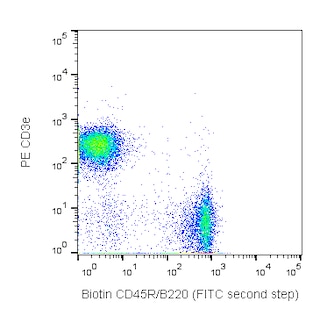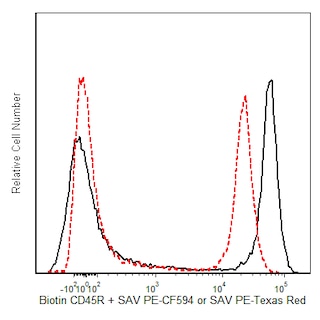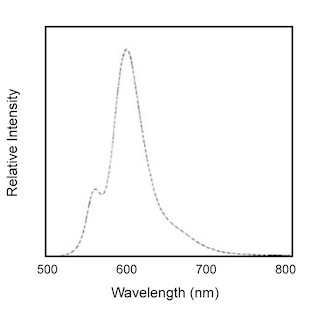-
Your selected country is
Middle East / Africa
- Change country/language
Old Browser
This page has been recently translated and is available in French now.
Looks like you're visiting us from {countryName}.
Would you like to stay on the current country site or be switched to your country?
BD Horizon™ PE-CF594 Streptavidin
(RUO)

.png)

Flow cytometric comparison of CD45R/B220 expression on mouse splenocytes using Biotin-conjugated Anti-Mouse CD45R/B220 antibody and either BD Horizon™ PE-CF594 Streptavidin or PE-Texas Red Streptavidin. Left Panel: BALB/c mouse spleen cells were stained with Biotin Rat anti-Mouse CD45R/B220 (Cat. No. 553086) antibody followed by BD Horizon™ PE-CF594 Streptavidin (Cat. No. 562284/562318; black line histogram). The dashed line histogram overlay represents staining on splenocytes with PE-CF594 Streptavidin alone. Right Panel: BALB/c mouse spleen cells were stained with Biotin Rat anti-Mouse CD45R/B220 antibody followed by either BD Horizon™ PE-CF594 Streptavidin (black line histogram) or BD Pharmingen™ PE-Texas Red™ Streptavidin (Cat. No. 551487, dashed line histogram overlay). Flow cytometric histograms were derived from gated events with the forward and side light-scatter characteristics of viable lymphocytes. Flow cytometry was performed using a BD™ LSR II Flow Cytometer System.
.png)

BD Horizon™ PE-CF594 Streptavidin
.png)
Regulatory Status Legend
Any use of products other than the permitted use without the express written authorization of Becton, Dickinson and Company is strictly prohibited.
Preparation And Storage
Product Notices
- Since applications vary, each investigator should titrate the reagent to obtain optimal results.
- When excited by the yellow-green (561-nm) laser, the fluorescence may be brighter than when excited by the blue (488-nm) laser.
- Please observe the following precautions: Absorption of visible light can significantly alter the energy transfer occurring in any tandem fluorochrome conjugate; therefore, we recommend that special precautions be taken (such as wrapping vials, tubes, or racks in aluminum foil) to prevent exposure of conjugated reagents, including cells stained with those reagents, to room illumination.
- Because of the broad absorption spectrum of the tandem fluorochrome, extra care must be taken when using multi-laser cytometers, which may directly excite both PE and CF™594.
- Texas Red is a registered trademark of Molecular Probes, Inc., Eugene, OR.
- CF™ is a trademark of Biotium, Inc.
- This product is provided under an Agreement between BIOTIUM and BD Biosciences. The manufacture, use, sale, offer for sale, or import of this product is subject to one or more patents or pending applications owned or licensed by Biotium, Inc. This product, and only in the amount purchased by buyer, may be used solely for buyer’s own internal research, in a manner consistent with the accompanying product literature. No other right to use, sell or otherwise transfer (a) this product, or (b) its components is hereby granted expressly, by implication or by estoppel. This product is for research use only. Diagnostic uses require a separate license from Biotium, Inc. For information on purchasing a license to this product including for purposes other than research, contact Biotium, Inc., 3159 Corporate Place, Hayward, CA 94545, Tel: (510) 265-1027. Fax: (510) 265-1352. Email: btinfo@biotium.com.
- Caution: Sodium azide yields highly toxic hydrazoic acid under acidic conditions. Dilute azide compounds in running water before discarding to avoid accumulation of potentially explosive deposits in plumbing.
- For fluorochrome spectra and suitable instrument settings, please refer to our Multicolor Flow Cytometry web page at www.bdbiosciences.com/colors.
- Please refer to www.bdbiosciences.com/us/s/resources for technical protocols.
Companion Products




Streptavidin is a non-glycosylated protein that is prepared chromatographically from the bacterium Streptomyces avidinii. Streptavidin homotetramers have a particularly high, non-covalent binding affinity for biotin. When conjugated with fluorochromes, streptavidin has been widely used with biotin-conjugated antibodies and other biotinylated specific-binding molecules (eg, recombinant proteins and lectins) to stain cells and tissues for subsequent multiparameter analysis by flow cytometry, fluorescence microscopy and imaging. Likewise, when conjugated with an enzyme (eg, Horseradish Peroxidase or Alkaline Phosphatase) and coupled with a colorimetric or luminescent substrate development system, streptavidin has found widespread use along with biotinylated antibodies in a number of applications including Western blot, ELISA, BD™ ELISPOT, immunocytochemistry and immunohistochemistry.
Streptavidin is conjugated to BD Horizon PE-CF594, which has been developed exclusively by BD Biosciences as a better alternative to PE-Texas Red®. PE-CF594 excites and emits at similar wavelengths to PE-Texas Red® yet exhibits improved brightness and spectral characteristics. Due to PE having maximal absorption peaks at 496 nm and 564 nm, PE-CF594 can be excited by the blue (488-nm), green (532-nm) and yellow-green (561-nm) lasers and can be detected with the same filter set as PE-Texas Red® (eg 610/20-nm filter).

Development References (2)
-
Diamandis EP, Christopoulos TK. The biotin-(strept)avidin system: principles and applications in biotechnology. Clin Chem. 1991; 37(5):625-636. (Biology). View Reference
-
Shapiro HM. Practical flow cytometry, 4th ed.. Hoboken, N.J.: Wiley-Liss; 2003:1-681.
Please refer to Support Documents for Quality Certificates
Global - Refer to manufacturer's instructions for use and related User Manuals and Technical data sheets before using this products as described
Comparisons, where applicable, are made against older BD Technology, manual methods or are general performance claims. Comparisons are not made against non-BD technologies, unless otherwise noted.
For Research Use Only. Not for use in diagnostic or therapeutic procedures.
Report a Site Issue
This form is intended to help us improve our website experience. For other support, please visit our Contact Us page.